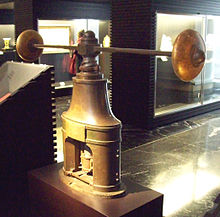Philippe Gengembre
Philippe Gengembre (born March 22, 1764 in Houdain , † January 19, 1838 in Indre (Loire-Atlantique) ) was a French chemist. Under Napoleon he was inspector general for money.
Gengembre was a student of Antoine de Lavoisier and assisted him and Pierre-Simon de Laplace, among other things, in their experiments on thermodynamics. From 1791 to 1794 he was in the USA, where he spied among the British on behalf of the Americans. After his return, he was quickly promoted to general inspector in the administration of banknotes and coins, thanks not least to his mechanical and chemical skills. He invented a new gravure printing method for bills and devices for striking the coins. His coin press of 1803 earned him the post of general inspector of coins under Napoleon. He later worked in the mint press in Nantes (today's Natural History Museum). In Indre he organized a royal factory for steam engines for ships from 1827. He is buried in Indre.
In 1789 he was the first to prepare hydrogen phosphide .
literature
- Michel Duchamp: Philippe Gengembre (1764-1838), Inspecteur Général de la Monnaie de Paris, The Medal, No. 16, 1990
- Gildas Salaün: Philippe Gengembre (1764–1838), du mécaniciens des Monnaies, au Directeur de la Manufacture Royale de Machines à Vapeur d'Indretm Neptuna, No. 305, October 2009
Web links
Individual evidence
- ↑ Gengembre, About a new air, which is obtained by the action of lye salts on Kunckel's phosphorus, Crells Chemische Annalen, Volume 11, 1789, pp. 450–457.
| personal data | |
|---|---|
| SURNAME | Gengembre, Philippe |
| BRIEF DESCRIPTION | French chemist |
| DATE OF BIRTH | March 22, 1764 |
| PLACE OF BIRTH | Houdain |
| DATE OF DEATH | January 19, 1838 |
| Place of death | Indre (Loire-Atlantique) |

